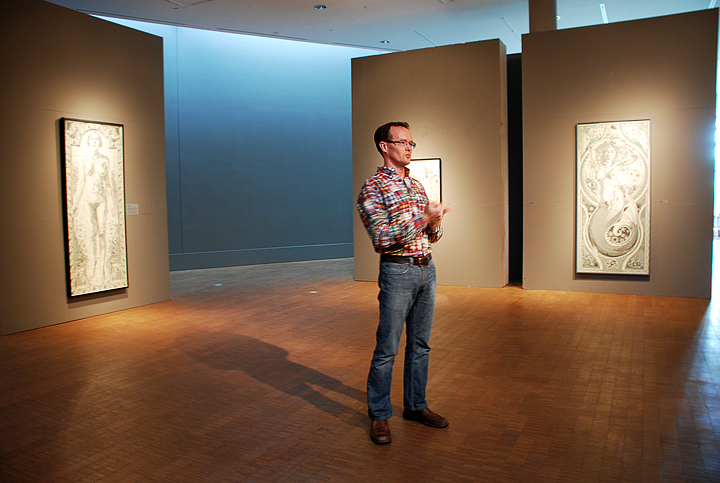
Daniel Strong wants you to see art through the eyes of a museum curator. Strong, who is the Associate Director of Grinnell’s Faulconer Gallery, curated the four simultaneous exhibitions that are now on display at Faulconer and spoke about the process last Tuesday. Strong explained how curators examine individual artists’ collections in galleries and how he has tried to replicate that experience for students in Grinnell. Though the works on display range in medium from video recordings to an anachronistic oil painting, they share themes of watching, being watched and the “packaged” image.
“Occasionally, you’ll find patterns and dialogues between artists, and that’s what I wanted to show here,” Strong said in his lecture to students and faculty members.
Televisions feature prominently in several of the exhibitions. Dutch painter Michael van den Besselaar’s “Unconscious Optics” includes pictures of TV screens that juxtapose similar and disparate images, such as George Bush and Darth Vader, along with photorealistic collages of retro-’ 70s terrorists and dead celebrities. Van den Besselaar’s best pieces are at once beautiful and unnerving, but a number of his displayed works lack the aforementioned thematic focus and leave the viewer unsatisfied. Though a series of images of houses evokes hyper-real perfection and superficiality for the viewer, the repetition induces unfortunate boredom.
“Unconscious Optics” is displayed parallel to actor/artist Harry Shearer’s video installation “The Silent Echo Chamber.” Shearer’s video recordings act effectively in conjunction with Van den Besselaar’s—they display short video loops of American public figures such as Obama and Anderson Cooper silently on camera. Strong noted the sort of “unpackaged” image that appears on a television—that is, one does not know what kind of picture to expect when turning on a TV, and consequently may encounter “images that get burned into our retinas, without any regard for what they may stand for in people’s minds.”
Strong described Shearer’s work as “not really a work of art at all,” merely a collection of DVDs with looped clips, which left Strong and Director of Exhibition Design Milton Severe with the task of creating installation. “The Silent Echo Chamber” is both a forceful and accessible piece, more so than much video art, and in addition provides a good-natured reminder of our and our celebrities’ shared humanity—watch for Anderson Cooper’s tics.
Strong hopes that students will both appreciate and learn from the exhibit.
“Especially in an academic setting, it’s important for students to see good technique,” he said.
The other two exhibits, Mark Wagner’s “Face Value” and Bryan Drury’s “Feast,” showcase the technical abilities of their respective artists. Drury’s portion features one painting, a figurativist nature scene, an oil painting that could have been painted in the 19th century. While it is indeed a technical achievement of popping colors and sparkling light, it is reminiscent of every painting in every art museum, ever. Wagner’s pictures, however, are instantly eye-catching. Wagner and his staff have assembled portraits from cut-up dollar bills—yes, the bills are real, and no, it is not illegal. The greenish results, at once funny and magical, took thousands of hours of work, and warrant close observation.
The decision to treat the gallery as four separate collections was a good one—while one can identify threads of connection, discovering any unifying theme or political message is difficult. This lack of clarity may well be intentional, and serve to accomplish Strong’s goal of showing Grinnell what it is like to curate an exhibit.
“[The exhibitions were a lovely insight into the inner workings of our gallery,” Elise Gallant ’12 said.
All four exhibitions run until Sep. 5.



















































Elizabeth Skarie • Sep 6, 2010 at 9:21 am
I wish I could see it.